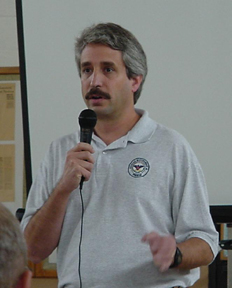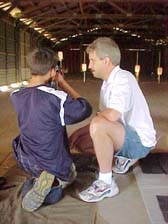ON TARGET With Bob Foth Escaping a Score Plateau Q: I seem to have run out of coaching skills, leaving my shooters stranded on a 210x300 plateau in 3P Sporter Rifle. Is there a usual suspect that causes this plateau? A: I certainly doubt you have run out of coaching skills. Just asking questions and seeking help is a vital coaching skill, so you are on the right track! Plateaus are a part of something I call the training effect. Training always pays off in the long run, but training is not always reflected in an immediate or steady rise in scores. |
 CMP Training Director Bob Foth, a three-time Olympian and Olympic silver medallist. |
| Shooters
scores typically rise, then level off, then rise again as their training
continues. Generally, the longer you are on a plateau, the bigger the jump
will be when you break through. Encourage your shooters to hang in there.
Start by checking two critical basics. First, require all of your shooters to use some type of journal/notebook/diary all the time. If your shooters have not used a shooters diary before, the CMP Shooters Diary is a good 'starter diary' and is available free of charge. Have them start by writing just a few words about what they did during their practice and what they want to do next. Once they see how this helps make their practices more effective, they should be motivated to do more. Second, make sure your shooter's equipment is working. Their rifles should be cleaned and lubed, with triggers adjusted and all screws tight. Stocks should fit the shooters. If possible, cut stocks shorter, saving the remnant as a spacer. This should help your shorter shooters tremendously. (I believe that nearly all rifle stocks are made too long for shooters less than 6 feet tall). To escape from a plateau, try making some changes in your training program. This should pique your athletes' interests. Run practice matches or record days. Try different courses of fire. Some coaches have various types of "fun" shoots as well. The most effective thing you can do during your practices is to get your shooters working on specific skills by using training exercises. There are resources with exercises available, but with a little thought you also can design your own exercises. The CMP's CD-ROM, Rifle Safety and Marksmanship Training, is a good resource for training exercises. 1. Contact the CMP Affiliate Relations (email: programs@odcmp.com) to request copies of the CMP Shooters Diary or download a copy of the "Order Form for CMP Education and Training Materials" from the CMP web site by clicking on http://www.odcmp.com/programorderform. Both the CD-ROM and the USAMU International Rifle Guide give great information about skills, techniques and positions. Next, let's look at some specific topics to work on. Talk with your shooters about these topics, and then have them focus on ONE item at a time. By focusing on one thing they can make changes much more rapidly. Toward the end of each of these sessions have them shoot some complete shots to bring what they just worked on into the integrated act of firing the shot. First, help your shooters learn to use their sights. They must know the distance and direction that a certain adjustment will move shots. Distance is usually expressed as clicks per ring. I like to have shooters shoot a "box" with shots in the corners, 10 or 20 clicks apart. They must move all four directions, then they can do the math. The number of clicks divided by the number of scoring rings the shots moved gives clicks per ring. Your shooters should not be afraid to adjust their sights! Every shooter needs a spotting scope to do this. |
| Other topics might include:
hold/dry fire (can be alternated with live shots), sight picture, trigger
control (just watch the finger movement), follow through, shot calling (have
them work with a partner who has a scope and can check shot locations after
they call shots without taking their heads off the stock.), and analysis
(USE the diary). Try having your experienced shooters assist in training
your newer shooters. Occasionally have the shooters work on just one position
for a whole training session. Another thing that will produce huge benefits is to teach your shooters to properly prepare each time they get into position. Here is the sequence. Always start by getting into position without the rifle; make sure the body position feels comfortable, relaxed and balanced. |
 On Target author Bob Foth coaches a junior who is shooting a sporter class air rifle. |
| Then get into position
with the rifle. Check the natural point of aim and balance (close eyes,
relax, check balance, open eyes - the shooter's head should not move and
he/she should be looking through the sights at the target). Take at least
one hold or dry fire repetition. Then "finally" shoot the shot. Most shooters
think it isn't fun to take an extra minute before they shoot, but most shooters
also think it is much more fun when they are shooting higher scores. These are some ideas about how to train smarter. You may also be able to get your shooters to train harder. Encourage them to use all of their range time wisely. 2. The CD-ROM Rifle Safety and Marksmanship Training and the USAMU International Rifle Guide can be ordered by downloading a copy of the "Order Form for CMP Education and Training Materials" from the CMP web site by clicking on http://www.odcmp.com/programorderform. Can you increase the number of hours per day, days per week, or weeks per year? Do they have equipment to dry fire or shoot at home? Are they healthy and physically fit? Have their eyes been checked recently? Have them work on aerobic conditioning, endurance, flexibility and balance. Most of these can be accomplished off the range, increasing training time without increasing range time. Get them to pay attention to the effects of diet on performance. The quickest change for most kids comes from cutting sodas out of the diet and replacing them with water. Caffeine and sugar are not beneficial. Finally, take your team to big matches where you can shoot against good teams. Kids will often have a performance jump after seeing kids "just like them" shooting top scores. If you do not set upper limits on your expectations for your shooters, they will surprise you with how high their scores will climb. |